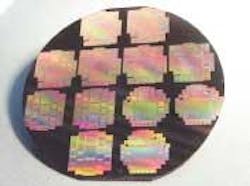Photonic-bandgap devices graduate to real applications
Introduced only a few years ago, photonic-bandgap crystals are now being incorporated into a first generation of devices. Ralf Wehrspohn, at the University of Paderborn (Paderborn, Germany), explains that these devices have potential applications in telecommunications, lighting, lasers, and sensing. "In all these devices, tuning and trimming of the photonic crystals' dispersion relation after fabrication is mandatory," he says.
As part of the SPIE annual meeting nanotechnology track (Aug. 2–6, 2004; Denver, CO), several researchers presented information on how—and why—the crystals' properties can be tuned.
In an invited talk, Henry van Driel, at University of Toronto (Toronto, Ontario, Canada), along with colleagues, including Wehrspohn and researchers from the California Institute of Technology (Pasadena, CA), discussed four methods for shifting the frequency of particular energy bands.1 They reported that they were able to create large shifts in the frequency of the band structure using liquid crystals, mechanical tuning, or optically injected free carriers. For fast changes, either free carriers or the nonlinear Kerr effect could provide gigahertz switching speeds with low changes in the refractive index. This work could lead to variable optical attenuators, tunable dispersion compensators, or fast optical switches.
The group uses a material system based on silicon, which offers easy integration with existing semiconductor processes (see figure). The unique approach of the Paderborn group comes from the combination of self-assembly methods with classical semiconductor technologies, notes Wehrspohn.
Researchers at Paderborn's new Center for Optoelectronics and Photonics are working with the industry to develop tunable telecommunications components and photonic-crystal gas sensors, as well as using nanophotonic materials to increase the efficiency of solar cells. Other groups worldwide are working in similar areas.
Sensing
Paul Braun and others at the University of Illinois at Urbana-Champaign are also developing photonic-bandgap structures for sensing, but take a nonsilicon route. The group is developing a method for creating 3-D photonic crystals by first forming a template with the appropriate periodicity and geometry using self-assembly and holographic lithography, then synthesizing within the template a second material with the appropriate optical and physical properties. The group has developed a method for introducing defects via multiphoton polymerization. "We've demonstrated the synthesis and characterization of robust films using colloidal crystal templating that tunes the photonic bandgap by physical deformation of easily functionalized hydrogels, involving both bulk swelling and pore structure deformation," researcher Yun-Ju Lee said.
At the conference, Lee described creating a self-assembled colloidal crystal to act as a template, then infiltrating the template with a hydrogel precursor.2 After UV polymerization and removal of the template, the group is left with a material with a Bragg-diffraction wavelength that shifts when an analyte is introduced. The shift corresponds to changes in the characteristic periodicity of the structure due to hydrogel swelling. The shift is reversible, and by using different functional groups, the researchers created devices that are sensitive to pH level, glucose concentration, and ionic strength.
Simulating photonic crystals
Shanhui Fan's group at Stanford University (Palo Alto, CA) is working on theory and simulations of photonic-crystal structures. "Theory and simulation play a very prominent role in photonic-crystal research because the underlying equations can be solved exactly using large-scale simulation techniques," explained Fan, "and thus simulation can be used as a computational experiment to realistically probe the behaviors of the crystal system."
The work allows the group to investigate new behaviors and possibilities. In an invited paper, Fan discusses new optical physics and devices that may be possible using tunable photonic crystals.3 Among the intriguing possibilities presented by this work is the possibility that light pulses could be stopped and stored coherently. This could eliminate a major constraint in optical systems, including telecommunications and computing. Other work has demonstrated self-collimation within photonic crystals, which could be used to create very high-efficiency bends and splitters, as well as devices such as mechanically switchable optical filters.
REFERENCES
- H. van Driel et al., SPIE annual meeting, Denver, CO, paper 5511-01, (2004).
- Y. Lee et al., SPIE annual meeting, Denver, CO, paper 5511-22, (2004).
- S. Fan, SPIE annual meeting, Denver, CO, paper 5511-22, (2004).
